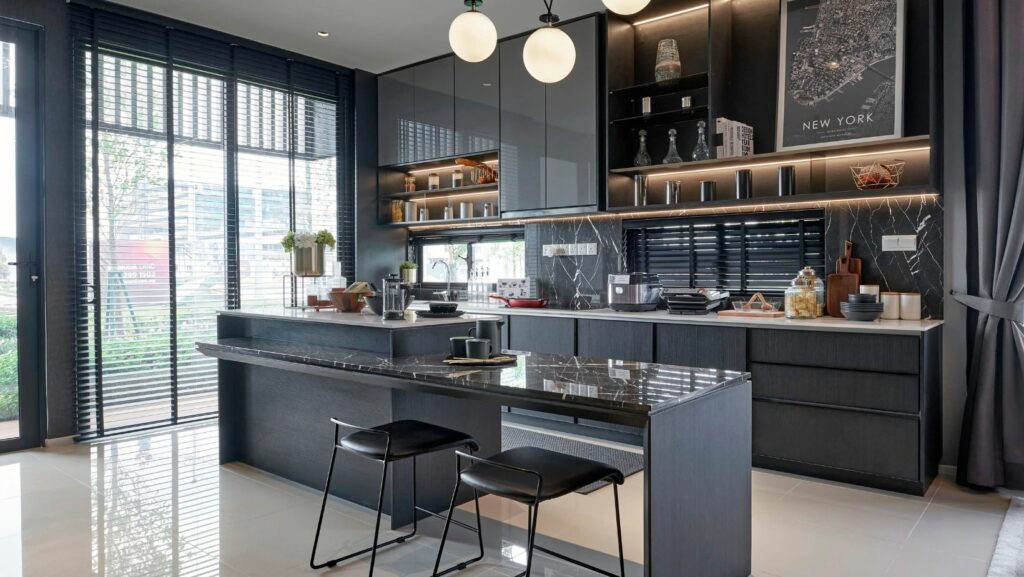Revamping your kitchen is a great way to elevate your space and add style. You can find creative ideas for your cabinet designs, from trendy materials like stainless steel to DIY projects and kitchen backsplash options.
Modern styles incorporating sleek and minimalist designs can help you create a contemporary aesthetic in your kitchen. Other options include using two-tone cabinets or open shelving to add visual interest to your room.
Sleek and Minimalist
The minimalist kitchen cabinets remodeling trend entails a sleek and uncluttered design. To get this look, choose frameless cabinets with smooth, flat fronts in a neutral color like white or gray. For cabinet hardware, opt for sleek European-style handles instead of traditional knobs and pulls.
Skip upper cabinets for a dramatic backsplash. Here, a countertop-to-ceiling backsplash of neutral patterned tile makes an eye-catching statement without distracting from the sleek and minimal cabinet design.
Minimalism also includes focusing on only the necessary items in your kitchen. Streamline your cookware by setting aside only the pots, pans, and dishware you use regularly to avoid clutter. Also, donate any duplicates or items you no longer use to maintain a streamlined storage area.
Vertical Cabinet Handles
Whether you use knobs or pull handles on your kitchen cabinetry, finding the proper placement can have a significant impact on both aesthetics and function. Generally, the larger the door panel is, the larger the hardware should be.
But don’t be afraid to break the rules and mix it up if you like! The decision to go with different handle finishes in this kitchen was based on a sense of whimsy and the ability to create a layered look that complements the cool metal tones of the faucet and appliances.
Getting the precise placement of your new cabinet hardware is all about a blend of patience and careful measuring. Using a cabinet hardware jig can also help eliminate guesswork, ensuring that your new knobs or pulls are perfectly aligned time and time again.
Asymmetrical Cabinet Handles
Cabinet hardware is an essential element in a kitchen, offering style and function. While choosing one style of handle for every door and drawer may be tempting, mixing different types is more visually attractive. Plus, some styles of handles work better for specific functions, such as bin pulls or more giant knobs for drawers and large trash pull-outs.
Generally, knobs create more of a visual impact and are best for cabinet doors, while pulls offer a sleek look and work well on drawers. Mixing knobs and pulls allows you to customize your space and ensure that the entire cabinet set is cohesive. Just guarantee the flat areas on your cabinets and drawers accommodate your chosen handle style. It will keep the handles from clashing with your cabinetry and creating an uneven aesthetic.
Open Shelving
Open shelving can be a bold storage solution for those with the time, energy, and budget to devote. Embrace this style to display your favorite dishes, glassware, and decor that would otherwise get lost behind cabinet doors.
Pair dark-painted walls and base cabinets with light wood open shelving to create contrast. Accent with white and use symmetry to tie the design together.
If you’re new to the exposed look of open kitchen shelves, start small and run a row above your stove for a convenient spot to store essentials like coffee mugs or a collection of spices. Illuminate your new shelf space with strip lighting to add a dramatic touch.
Peel-and-Stick Backsplash Tiles
A backsplash is one of the easiest ways to revamp your kitchen without breaking the bank. However, it is essential to consider your budget and the value your backsplash will add to your home when deciding.
Backsplash tiles are available in a variety of materials and patterns. Choose a material that complements your kitchen, such as low-maintenance vinyl or elegant metal.
Before installing, make sure to prep your wall surface properly. It includes sanding rough areas and applying a skim coat to the wall if necessary. Once you have a smooth surface, cut the tile if needed and start the installation process.


More Stories
Essential Tips for Purchasing the Perfect Sofa
Essential Tips for Hiring the Right Construction Company
Common Plumbing Issues and Practical Pro Tips on Solving Them